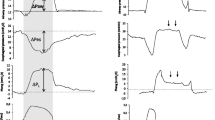Abstract
We studied the changes in end-tidal CO2 (ETCO 2) and systemic responses after tourniquet deflation in spontaneously breathing and ventilation-controlled patients during orthopedic surgery of both the upper and/or the lower extremities. In most patients, increases in ETCO 2, heart rate, and PaCO 2, as well as decreases in blood pressure and pH were observed. In every spontaneously breathing patient, the respiratory rate began to increase before the ETCO 2 reached a maximum. Arterial blood gas analysis suggested that the increase in ETCO 2 closely reflected the increase in PaCO 2. Our study yielded new information on the ETCO 2 changes as follows: 1) the time for ETCO 2 level to reach a peak (peak time) was almost constant despite the considerable differences in the increases in ETCO 2 both in spontaneous breathing and ventilation-controlled groups and the peak time in the former group was shorter than that in the latter group; and 2) it was suggested that the increase in ETCO 2 in the spontaneously breathing patients was smaller than that in ventilation-controlled patients when both patients were subjected to the same conditions on tourniquet time and tourniqueted area. Our data showed that the increase in ETCO 2 (or PaCO 2) can be large and prolonged in some situations. Thus, we recommend continuous ETCO 2 monitoring and the proper hyperventilation at tourniquet deflation in order to minimize any adverse effects of acidosis.
Similar content being viewed by others
References
Lynn AM, Fischer T, Brandford HG, et al: Systemic responses to tourniquet release in children. Anesth Analg 65:865–12, 1986
Patel AJ, Choi CS, Giuffrida JG: Changes in end-tidal CO2 and arterial blood gas levels after release of tourniquet. South Med J 80:213–6, 1981
Bourke DL, Silberberg MS, Ortega R, et al: Respiratory responses associated with release of intra-operative tourniquet. Anesth Analg 69:541–4, 1989
Shaw Wilgis EF: Observations on the effects of tourniquet ischemia. J Bone Joint Surg 53A:1343–6, 1911
Deen L, Nyst CLTM, Zurrmond WWA: Metabolic changes after tourniquet release. Acta Anesthesiol Belg 33:101–14, 1982
Paulus DA: Capnography (review article). Int Anesthesiol Clin 21:167–175, 1989
Miller RH: Textbook of Basic Emergency Medicine, 2nd ed. St. Louis, The C.V. Mosby Co., 1980
Guyton AC: Textbook of Medical Physiology, 7th ed. Philaderphia, W.B. Saunders Co., 1986, pp. 848
Wasserman K, Beaver WL, Whip BJ: Gas exchange theory and the lactic acidosis (anaerobic) threshold. Circulation 81 (suppl II): 14–30, 1990
Modig J, Kolstad S, Wigram A: Systemic reaction to tourniquet ischaemia. Acta Anesthesiol Scand 22:609–14, 1918
Benzon HT, Toleikis JR, Meagher LL, et al: Changes in venous blood lactate, venous blood gases, and somatosensory evoked potentials after tourniquet application. Anesthesiology 69:611–82, 1988
Valli H, Rosenberg PH, Kytta J, et al: Arterial hypotension associated with the use of a tourniquet with either general or regional anesthesia. Acta Anesthesiol Scand 31:219, 1981
Miller RD: Anesthesia, 3rd ed. New York, Churchill Livingstone Inc, 1990, pp. 1963
Author information
Authors and Affiliations
About this article
Cite this article
Akata, T., Tominaga, M., Sagiyama, M. et al. Changes in end-tidal CO2 level following tourniquet deflation during orthopedic surgery. J Anesth 6, 9–16 (1992). https://doi.org/10.1007/s0054020060009
Received:
Accepted:
Published:
Issue Date:
DOI: https://doi.org/10.1007/s0054020060009




